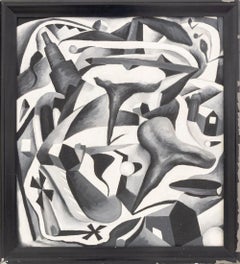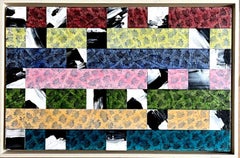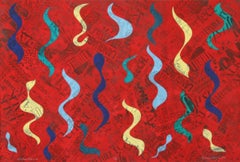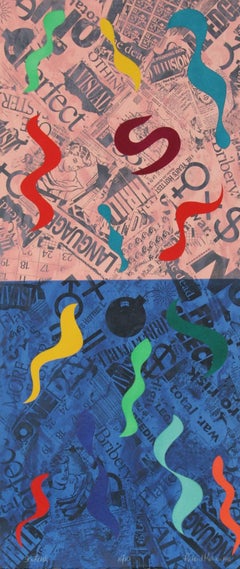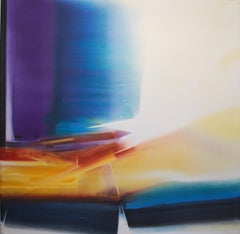Richard Kalina Art
to
1
1
1
2
Overall Width
to
Overall Height
to
4
1
3
2
2
2
2
2
2
2
2
1
4
9,475
2,687
1,375
1,358
2
2
4
Artist: Richard Kalina
"Central States"
By Richard Kalina
Located in Astoria, NY
Richard Kalina (American, b. 1946), "Central States", Oil on Canvas, 1985, signed, dated, and titled to verso with gallery label, black lacquered frame. Image: 21.75" H x 19.5" W; fr...
Category
1980s Abstract Richard Kalina Art
Materials
Canvas, Oil
Face Value
By Richard Kalina
Located in New York, NY
Richard Kalina
Face Value, 1992
Collage and mixed media (flasche) and acrylic on laid paper painted on canvas
Signed on the verso; also bears Max Protech Gallery Label, Unique
Frame included
Hand signed, dated and titled on the verso with original label from the legendary Max Protech Gallery, as well as Christie's NYC labels. A dazzling mixed media painting that looks so much better in person.
Provenance
Max Protech Gallery
Christie's Inc (see labels)
Measurements:
Frame:
15.5 x 23.5 x 1 inch
Artwork:
15 x 23 inches
About Richard Kalina:
Richard Kalina was born in 1946 and studied at the University of Pennsylvania. He began exhibiting in 1969 and has regularly shown his work in museums and galleries, both nationally and internationally. ... Richard Kalina is Professor of Art at Fordham University in New York, where he teaches studio art and art history. This is a gorgeous work that would look beautiful in any home or office.
His works are included in museum collections such as the Arkansas Art Center, Grey Art Gallery, Guild Hall Museum, Fogg Art Museum, Indianapolis Museum of Art, Milwaukee Art...
Category
1990s Abstract Richard Kalina Art
Materials
Canvas, Mixed Media, Acrylic, Laid Paper, Vinyl
Western Medicine, Pop Art Lithograph by Richard Kalina
By Richard Kalina
Located in Long Island City, NY
Artist: Richard Kalina
Title: Western Medicine
Year: 1993
Medium: Lithograph and Collage, signed and numbered in pencil
Edition: 20
Paper Size: 28.5 x 42 in. (72.39 x 106.68 cm)
Category
1990s Pop Art Richard Kalina Art
Materials
Lithograph
$640 Sale Price
20% Off
Sea Level, Pop Art Abstract Lithograph by Richard Kalina
By Richard Kalina
Located in Long Island City, NY
Artist: Richard Kalina
Title: Sea Level
Year: 1993
Medium: Lithograph with Collage, signed and numbered in pencil
Edition: 20
Paper Size: 42 in. x 18 in. (106.68 cm x 45.72 cm)
Category
1990s Pop Art Richard Kalina Art
Materials
Lithograph
Related Items
Brighter than the Sun, James Rosenquist: colorful abstract pop art rainbow
By James Rosenquist
Located in New York, NY
This vibrant red, blue, orange and yellow lithograph is based on the 1961 Rosenquist oil painting Brighter than the Sun (private collection), with fragmented images from advertising,...
Category
Late 20th Century Pop Art Richard Kalina Art
Materials
Lithograph
Beginnings I Large Abstract Painting
Located in Lake Worth Beach, FL
Beginnings I, 2014
Fine Art vinyl paint on primed canvas gallery wrap.
Frank Monaco American artist born in 1944.
Studied and worked with Marilyn Stiles of The Art Institute of Chicago/ Art History
Painting, Museum Restoration and Preservation, 1972 – 1976
New York University Fine Arts Studies, 1977 – 1978
Licensed Art School, Hollywood, FL, St Augustine, FL
Faculty member of South Florida Institute
Co-Founder “Artist Foundation”, Hollywood, Florida
Exhibition:
Boca Raton Museum Guild, FL
Museum of Art and History, Palm Beach County, FL
Solo Exhibition:
2012 “Pieces” 233 West King Gallery, St. Augustine, Florida
2005 “Caught Up in Colors”, Opening Reception, Frank Monaco Studio, Flagler Healthcare Foundation Benefit, St. Augustine, Florida
2004 Sanmar Gallery, St. Augustine, Florida
2001 Art & Culture Center, Hollywood, Florida
1997 Art & Cullture Center, Hollywood, Florida
1992 Artist Foundation of Broward, Fifteen Years, 1977 – 1992
1991 Lane Gallery, Key West, Florida
1991 Gallery Des Artistes, West Palm Beach, FL
1991 Philip Janes, Art Exclusive Gallery, Connecticut, One Artist, Two Shows
1990 Philip Matheson Janes Museum Exhibition, Fisher Gallery, Avon, CT
1990 Ballet Passions of Light, Collaboration with Karen Whitley Three Women in Dance, Torrington, Connecticut
1989 Boca Raton Museum, Florida Artist Series #9
1987 Steiner Gallery, Bal Harbour, Florida
1987 Matthew Scott Gallery, Miami
1986 Broward Community College Gallery, Davie Campus, Florida
1985 Walker Gallery Chicago, Illinois
1982 Hollywood Art and Culture Centr, Hollywood, Florida
1981 Medici – Berenson Gallery, Bay Harbour Island, Florida
1980 Carol Hooberman Gallery, Michigan
1976 Kottler Gallery, New Your, New York
Group Exhibits
1992 Boca Raton Museum – All Florida Exhibition
1990 Making Waves Exhibition, Hollywood Art & Culture Center, Florida
1989 Hartford Council for the Arts Award – Excellence in Painting Purchase Simsbury Library
1987 World Bank Award for Watercolor – New York City Exhibition
1986 Visual Arts Center, InterAmerican Relations New York City
1985 21st Century Gallery...
Category
2010s Abstract Richard Kalina Art
Materials
Canvas, Vinyl, Acrylic
Beach mediterranean seascape oil on canvas painting
Located in Sitges, Barcelona
Frameless
Category
2010s Abstract Expressionist Richard Kalina Art
Materials
Oil, Canvas
$519 Sale Price
44% Off
H 55.12 in W 31.89 in
SIGNED Frank Stella poster 1980 Democratic Convention colorful vintage Pop
By Frank Stella
Located in New York, NY
Colorful vintage poster for the 1980 Democratic National Convention, held in Madison Square Garden in New York.Concentric lines of orange and bright green interweave with strokes of ...
Category
1980s Pop Art Richard Kalina Art
Materials
Lithograph
Fold, Contemporary Abstract Collage Painting
Located in Philadelphia, PA
Collage has always been a part of the artist's work. The idea of reusing, recontextualizing, and even resurrecting parts of the painting. From an economic standpoint the materials ar...
Category
2010s Abstract Geometric Richard Kalina Art
Materials
Canvas, Acrylic, Vinyl
Leo Castelli Gallery (Landscape with Red Sky) Poster /// Roy Lichtenstein Pop
By Roy Lichtenstein
Located in Saint Augustine, FL
Artist: (after) Roy Lichtenstein (American, 1923-1997)
Title: "Leo Castelli Gallery (Landscape with Red Sky)"
Year: 1985
Medium: Original Offset-Lithograph, Exhibition Poster on smoo...
Category
1980s Pop Art Richard Kalina Art
Materials
Lithograph, Offset
$900
H 38.5 in W 23.5 in
Vintage Frank Stella poster Democratic Convention 1980 colorful Pop political
By Frank Stella
Located in New York, NY
Colorful vintage poster for the 1980 Democratic National Convention, held in Madison Square Garden in New York.Concentric lines of orange and bright green interweave with strokes of pink, yellow, red, turquoise, silver, and gold. Printed with metallic ink that catches light differently from each angle, complementing the poster’s lime green and red text. The top of the poster reads “Let us move forward with a strong and active faith.”
It was at this 1980 convention that Jimmy Carter was nominated for reelection. This large poster was printed by Petersburg Press in 1980, and features Frank Stella’s Polar...
Category
1980s Pop Art Richard Kalina Art
Materials
Lithograph
Untitled
Located in Berlin, MD
Stanley Sporny (American 1946 - 2008) A view into a stream with overhanging branches reflected in the water. A beautiful oil painting that explores the stream bottom as well as the ...
Category
Late 20th Century Abstract Impressionist Richard Kalina Art
Materials
Canvas, Oil
A Mexican Hillside Village Scene
Located in San Francisco, CA
The understated palette is the surprise here, given that it’s Mexico. No blinding white plaster walls. No bright green palms, hot pink bougainvillea and turquoise sea on the horizon,...
Category
20th Century Abstract Richard Kalina Art
Materials
Canvas, Oil
Nara Girl Banging On A Drum With Limited Edition Sticker Set Pop Art Print
By Yoshitomo Nara
Located in Draper, UT
Banging the Drum
DETAILS
27 x 17 inches (unframed), 2020
Offset lithograph
80# Classic Linen Solar White Cover
Category
2010s Pop Art Richard Kalina Art
Materials
Lithograph
Suckers State I
By Wayne Thiebaud
Located in New York, NY
A very good impression of this lithograph on Rives BFK. Signed, inscribed "state I" and numbered 111/150 in pencil. Printed and published by Gemini G.E.L., Los Angeles, with the blin...
Category
1960s Pop Art Richard Kalina Art
Materials
Lithograph
Modern Print /// Roy Lichtenstein Pop Art Abstract Geometric MoMA Gemini G.E.L.
By Roy Lichtenstein
Located in Saint Augustine, FL
Artist: Roy Lichtenstein (American, 1923-1997)
Title: "Modern Print"
*Numbered, signed, and dated by Lichtenstein in pencil lower right
Year: 1971
Medium: Original Lithograph and Scr...
Category
1970s Pop Art Richard Kalina Art
Materials
Lithograph, Screen
Richard Kalina art for sale on 1stDibs.
Find a wide variety of authentic Richard Kalina art available for sale on 1stDibs. If you’re browsing the collection of art to introduce a pop of color in a neutral corner of your living room or bedroom, you can find work that includes elements of blue, red and other colors. You can also browse by medium to find art by Richard Kalina in lithograph, acrylic paint, canvas and more. Much of the original work by this artist or collective was created during the 1990s and is mostly associated with the Pop Art style. Not every interior allows for large Richard Kalina art, so small editions measuring 18 inches across are available. Customers who are interested in this artist might also find the work of August Mosca, Steven Sorman, and Robert Kuszek. Richard Kalina art prices can differ depending upon medium, time period and other attributes. On 1stDibs, the price for these items starts at $640 and tops out at $10,000, while the average work can sell for $800.
